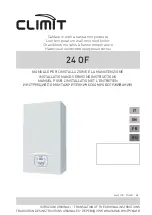
8
vENTING SySTEM INSPECTION & INSTALLATION
RIDGE
2’ (.61 M) MIN.
MORE THAN 10’ (3.1 M)
10’ (3.1 M)
HEIGHT ABOVE ANY
ROOF SURFACE WITHIN
10’ (3.1 M)
HORIZONTALLY
CHIMNEY 3’ (.92 M)
GAS VENT OR
TYPE L VENT
2’ (.61 M) MIN.
mately ¼" per foot. Bolt or screw joints together to avoid
sag.
If an oil fired water heater is vented into the same flue as
the boiler, provide a separate hole into the chimney when
-
ever possible. When this isn’t possible, use a “Y” connec
-
tion in the flue pipe, using a separate draft regulator for
each unit. When a chimney will not provide adequate draft
to handle the input from the water heater and boiler simul
-
taneously, wire the units so that only one will operate at a
time, favoring the water heater.
OIL TANK AND PIPING
Oil tank and piping should be installed in accordance with
the National Board of Fire Underwriters and local regula-
tions. Oil storage tank, vent, fill pipe and caps should be as
prescribed by local codes. In no case should the vent pipe
be smaller than 1¼" I.P.S. The fill pipe should not be less
than 2" I.P.S.
The suction line from the tank to the burner should be one
continuous piece of tubing to prevent air entering the line.
The suction line, must be ⅜" O.D. copper tubing for runs of
50 feet or less, and ½" O.D. for longer runs. An oil return
line, same size as the suction line, must be used on any
installation where the bottom of the tank is below the fuel
unit of the burner. Oil lines should be buried or otherwise
protected from mechanical injury. Flare fittings on all oil
lines are recommended. Compression fittings on the suc
-
tion line often allow air to be drawn into the fuel pump, mak
-
ing it difficult to maintain oil pressure at the nozzle. Do not
run overhead fuel lines from tank to oil burner.
Fuel pump connections and by-pass should be made ac
-
cording to instructions attached to the fuel pump. If tank is
Boiler is to be vented by natural draft and shall
not be connected into any portion of a me
-
chanical draft operating system under a posi
-
tive pressure.
WARNING
!
Inspect chimney to make certain it is constructed accord
-
ing to the latest revision of the NFPA 211. Local regulations
may differ from this code and should be checked. Where
there is a conflict, the local code will prevail.
The boiler must be installed into a chimney which has a
masonry or metallic chimney liner.
An unlined chimney will have leaks that will cause poor
chimney performance (no draft), and could result in a posi
-
tive pressure in the combustion chamber.
Horizontal portions of the venting system should not exceed
10 feet in length. Horizontal lengths over 10 ft. will have a
negative effect on the chimney performance.
The chimney should extend at least 2 ft. above any portion
of the building within 10 ft.
(
Figure #11
)
It should produce
a -.02 inch W.C. draft in the combustion chamber. See
"Chimney or Vent Sizes" chart for recommended minimum
and maximum chimney or vent sizes.
Inadequate draft will cause improper combustion, resulting
in dirty flue ways and high fuel bills.
Connect flue pipe same size as boiler outlet to chimney,
sloping upward continuously toward the chimney approxi
-
CHIMNEY OR VENT SIZES
BTU/HR INPUT
ROUND
INCHES
SQUARE
INCHES
HEIGHT
(FT)
MIN MAX MIN MAX MIN MAX
91,000 - 140,000 6
8
8x8 8x8
15
40
175,000 - 210,000 7
8
8x8 8x10 15
40
245,000 - 280,000 8
10
8x8 8x12 15
50
315,000
8
10
8x8 8x12 15
50
385,000
8
10
8x8 8x12 15
50
Figure #11









































